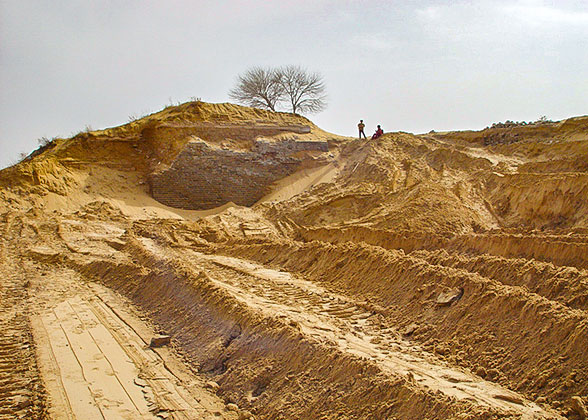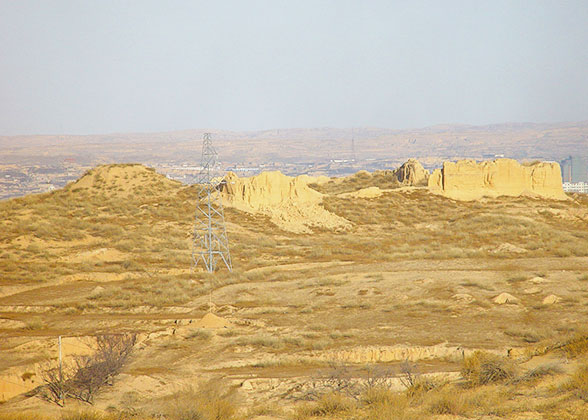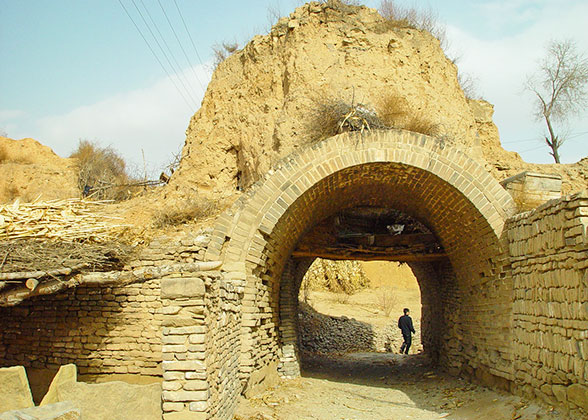According to a Chinese news agency, in 2008, a coal mining company - Shaanxi Sanxin Group - had pulled down a section of Great Wall of the
Ming Dynasty (1368 - 1644) with a length of over one kilometer (0.6 mile) in Fugu County,
Yulin, Northern
Shaanxi, just in order to level the land for building a new workshop. Some villagers had witnessed the horrible and heartbreaking scene. They felt sorry for it but no one dared to stop it. Even the officials from the local Bureau for Preservation of Cultural Relics had been threatened by the employees of Sanxin.
How can the destroyers be so presumptuous and shameless! Actually the contradiction between the protection of the Wall and the development of the local economy has long been a headache for the local department for cultural administration.
History and Current Situation of Yulin Great Wall
Yulin, located in Northern Shaanxi and to the south side of the bend of the Yellow River, adjoins Erdos to the north, Northern Shanxi to the east, Gansu to the west and Guanzhong Plain to the south. It had always been a strategic stronghold in ancient time, and thus many defensive walls had been built here in different dynasties. The magnificent walls weather through hundreds of years and the major formation remains. However, the relics face serious threats from the coal mining industry in recent years.
Coal Mining and Economic Development
Yulin located deep in the hinterland used to be a close and poor area. In 1984, exciting news activated the city. The biggest coal mine of the world had been discovered here! The Erdos Coal Mine (including Erdos of Inner Mongolia, Northern Shaanxi, and parts of Ningxia, Shanxi and Gansu) has proved reserves of 366.7 billion tons, which accounts for one third of the whole verified reserves of the coal in China. Among them, 87.7 billion tons are detected in Yulin. About 54% of Yulin’s land has coal and other mineral resources like natural gas, oil and halite stored underground, accounting for 45% of the whole volume of the energy resources of China. The potential value of these mines is over 40 trillion, and thus Yulin get its nickname as “Kuwait of China”. The local economy rockets as the exploitation of the mines. The over 20% annual growth of the local GDP makes everyone wide-eyed and tongue-tied.
Destruction of the Great Wall
 |
| Destroyed Great Wall Relics |
The coal mines distributing under over half of the city’s land means not only a happy event with surprise and fortune, but also a difficulty and even a nightmare. It is inevitable to destroy the land formation when excavating the coal, and further to cause some geological disasters. The sinkage of the goaf happens frequently, and some sometimes causes earthquakes, landslides and serious destruction to the local residences. The villagers can even hear the shake of the windows from time to time. The mining area becomes very dangerous to live. Some villages have all the locals moved out, but how about the historical relics on the land? They can’t be moved! At present, many sections of the Great Wall in Yulin are in danger.
"It is said that a coal mining project will be set in the Red Rock Gorge. This area will be totally destroyed!” said Wang Hongbin, the director of the local Cultural Relics Administration Bureau, to his colleague Liu Wenfa.
"I can’t believe it!” Liu shouted, “There is no coal in the gorge. It’s impossible to mine”
Wang explained, “The coal is lying underground. The excavation work will be extended under the gorge and soon the geological stratum will be empty.”
The dialogue makes one tremble, but it is the truth. That’s the really situation that the rear cultural relics face. There are some relics of the Ming Dynasty Great Wall on the mountain south of the Red Rock Gorge. To the north, it is the Site of the Horse Exchanging City, the once largest market between Hans and Mongolians. Besides, there lies the famous Pacify-the-North Tower (Zhenbeitai). All of these relics are to some extent in danger now.
In 2007, Shaanxi Great Wall Investigation Team found a beacon tower inclined in Qingshui Village of Fugu County, Yulin. In 2009, Yulin Archaeological Team entered the Shuitougou Village of Shenmu County and found it to be a no man zone. The roads were destroyed and the ancient Huadun Beacon Tower of the Great Wall cracked due to the coal mining.
Sanxin Group’s Destruction to the Great Wall
For the devilry of the Sanxin Group this time, there were eyewitnesses; however the department concerned said that the report was not true. The staff of Sanxin Group only found some bricks and rammed earth when they flatted the land. They just didn’t know it was the Great Wall. The authority said that the punishment had already been made in 2008. The Group was asked to pay a penalty of CNY 500,000 and to make a permanent symbol for the protection of the Wall.
It is reported that the annual coal output of Sanxin Group is over 600,000 tons and the annual tax to the government is over CNY 98 million. The company can also employ more than 1500 people, and thus makes great contribution to the local economy. So some people doubted the implementation of the punishment and the authority might conceal the truth to maintain their good image. No one knows the truth now, but it is the fact that the Great Wall had already disappeared. What a pity!
Caution for Protecting the Wall
Great Wall of the Ming Dynasty is the largest cultural relic in the world. Building this gigantic project once consumed prodigious manpower, material resources and time. However, only 20% of the wall maintains in good condition, and only 30% has clear formation that can be recognized. The situation in Yulin is more serious and urgent! If the local enterprises continue to seek the profit in defiance of the protection of the natural environment and the culture heritage, Yulin without a charming scene of wonderful mountains and waters and also the magnificent Walls will be a dead and dull city with only coal and money left.
The regulation on the protection of the Great Wall should not be a mere scrap of paper. It should be practically implemented and the Cultural Relics Administration Bureau needs to regulate the construction of the local projects. Dismantling, building through or moving the wall should be strictly forbidden. When building some necessary infrastructures, complete plans should be made in advance under the direction of the Cultural Relics Administration Bureau to keep away from the Great Wall.
Having learnt a lesson from Sanxin Group’s incident, the local government has invested more money on the protection of the Great Wall in recent years. CNY 10 millions was provided to protect the cultural heritage. In 2008, special workstations were established and three workers were in charge of the vegetation and environment protection around the Wall.
- Last updated on Jan. 19, 2024 by Brenda Lian -


